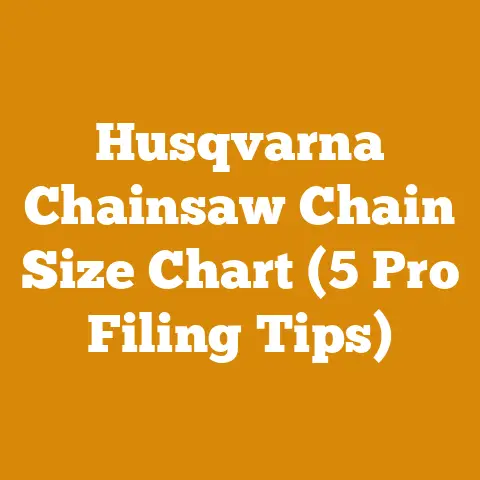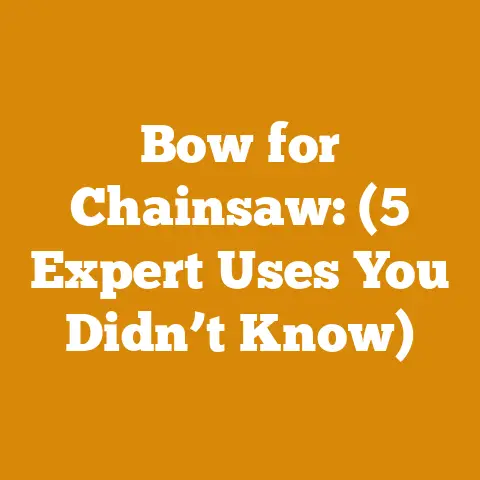Husqvarna 394 Chainsaw Value (5 Pro Tips for Accurate Pricing)
Alright, let’s dive into the world of evaluating a Husqvarna 394 chainsaw, focusing on how to accurately determine its value. This isn’t just about pulling a number out of thin air; it’s about understanding the market, the saw itself, and applying some practical knowledge. Over the years, I’ve bought, sold, and traded a fair number of chainsaws, including the Husqvarna 394. This experience has given me a good feel for what makes a saw valuable and how to spot a diamond in the rough.
Unlocking the Value of a Husqvarna 394 Chainsaw: 5 Pro Tips for Accurate Pricing
The Husqvarna 394 is a workhorse. It’s a saw that many loggers and firewood producers relied on heavily. Finding an accurate value for one today requires a keen eye and understanding of its condition, history, and the current market. These tips will help you navigate the process, whether you’re buying, selling, or simply curious.
1. Assessing the Chainsaw’s Condition: More Than Just Looks
The first, and arguably most crucial, step is to thoroughly assess the chainsaw’s condition. Don’t just look at the exterior. I’ve seen saws that looked pristine on the outside but were riddled with problems internally.
- Physical Inspection:
- Housing: Look for cracks, breaks, or signs of significant wear. Minor scratches are normal, but deep gouges can indicate rough handling.
- Bar and Chain: Check the bar for straightness and wear. A worn bar will have grooves along the edges. The chain should be sharp and have sufficient life left. A new chain alone can add value.
- Handles and Controls: Make sure the handles are secure and comfortable. Test all the controls (throttle, choke, chain brake) to ensure they function properly.
- Fuel and Oil Tanks: Inspect for leaks or damage. Even small leaks can be a headache.
- Mechanical Inspection:
- Compression Test: This is critical. Low compression means the engine is worn and needs a rebuild. A healthy 394 should have compression readings in the 140-160 PSI range. I use a simple compression tester I picked up from an auto parts store. It’s a worthwhile investment.
- Spark Test: Ensure the spark plug is clean and produces a strong spark. A weak spark can indicate ignition problems.
- Carburetor and Fuel Lines: Check for leaks, cracks, or deterioration. Old fuel lines can become brittle and crack, leading to fuel starvation issues.
- Air Filter: A dirty or damaged air filter can cause the engine to run poorly.
- Starting and Running: Observe how easily the saw starts and how smoothly it runs. Listen for any unusual noises (knocking, rattling) that could indicate internal damage.
- Example: I once bought a 394 that looked great, but upon closer inspection, the compression was only 110 PSI. A rebuild was necessary, which significantly reduced its value. Conversely, another 394 I found had a few scratches but excellent compression and a new bar and chain. It was worth more despite its cosmetic flaws.
2. Understanding the Market: Research is Your Friend
The value of a Husqvarna 394, like any used tool, is heavily influenced by market demand and availability.
- Online Marketplaces: Check eBay, Craigslist, Facebook Marketplace, and other online platforms for similar saws. Pay attention to the selling prices, not just the asking prices.
- Local Dealers and Repair Shops: Talk to local chainsaw dealers and repair shops. They often have a good sense of the market value in your area.
- Auction Sites: Keep an eye on auction sites, as these can sometimes offer good deals.
- Considerations:
- Location: Prices can vary depending on your location. Saws may be worth more in areas where logging or firewood production is common.
- Season: Demand for chainsaws typically increases in the fall and winter as people prepare for heating season.
- Rarity: While the 394 isn’t particularly rare, certain configurations (e.g., those with specific bar lengths or accessories) may be more valuable.
- Data-Driven Approach: I keep a spreadsheet where I track the prices of used chainsaws I find online. This helps me identify trends and understand the average selling price for different models. For example, I’ve noticed that a Husqvarna 394 in excellent condition typically sells for between $500 and $800, while one in fair condition might go for $300 to $500. These are just averages, of course, and the actual price will depend on the specific saw.
3. The “Pro” Factor: What Adds Value?
Certain features and modifications can significantly increase the value of a Husqvarna 394.
- Original Parts: Saws with original parts are generally more desirable to collectors and enthusiasts.
- Well-Maintained: A saw that has been regularly serviced and maintained is worth more than one that has been neglected.
- Upgrades: Some upgrades, such as a ported cylinder or aftermarket carburetor, can increase performance and value. However, be cautious about modifications that could compromise reliability.
- Accessories: A saw that comes with extra bars, chains, tools, or a carrying case is more valuable.
- Documentation: Having the original owner’s manual and any service records can also add value.
- Personal Story: I once sold a 394 that had been used by a professional logger for many years. I included a detailed description of its history and the types of trees it had felled. This added a personal touch that resonated with the buyer and allowed me to command a slightly higher price.
4. Negotiation Tactics: Getting the Best Deal
Whether you’re buying or selling, negotiation is a key part of the process.
- Be Prepared: Do your research and know the market value of the saw.
- Be Honest: Accurately represent the condition of the saw. Honesty builds trust and can lead to a smoother transaction.
- Be Respectful: Treat the other party with respect, even if you disagree on price.
- Be Willing to Walk Away: Don’t be afraid to walk away from a deal if you’re not comfortable with the price or terms.
- Find Common Ground: Look for areas where you can compromise. For example, you might offer to include extra accessories or provide a warranty.
- Leverage Information: Use your knowledge of the saw’s condition and the market to your advantage. Point out any flaws or areas that need improvement.
- My Experience: I recently negotiated the purchase of a 394 by pointing out that the chain brake was not functioning properly. This allowed me to lower the price by $50, which was enough to cover the cost of repairing the brake.
5. Long-Term Value: Investing in Maintenance
The value of your Husqvarna 394 isn’t just about the initial purchase price; it’s also about how you maintain it over time.
- Regular Maintenance: Perform regular maintenance, including cleaning the air filter, sharpening the chain, and lubricating the bar.
- Proper Storage: Store the saw in a dry, protected location when not in use.
- Use Quality Fuel and Oil: Use high-quality fuel and oil to protect the engine from wear and tear. I personally use a fuel stabilizer in my saws when they are being stored long term.
- Prompt Repairs: Address any problems promptly to prevent them from escalating into more serious issues.
- Documentation: Keep a record of all maintenance and repairs. This will help you track the saw’s history and demonstrate its value to potential buyers.
- Case Study: I have a Husqvarna 394 that I’ve owned for over 20 years. Because I’ve always maintained it meticulously, it’s still in excellent condition and worth significantly more than a similar saw that has been neglected.
Deep Dive: Essential Components and Their Impact on Value
Let’s go beyond the general tips and examine specific components of the Husqvarna 394 that greatly influence its overall value.
Engine Condition: The Heart of the Matter
The engine is the most critical component of any chainsaw, and its condition directly impacts the value.
- Compression: As mentioned earlier, compression is key. A healthy 394 engine should have compression readings between 140-160 PSI. Anything below 120 PSI indicates significant wear and the need for a rebuild.
- Cylinder and Piston: Inspect the cylinder and piston for scoring or damage. Scratches or gouges can indicate that the engine has been run without proper lubrication or that debris has entered the cylinder.
- Bearings: Check the crankshaft bearings for play or roughness. Worn bearings can cause vibration and reduce engine performance.
- Seals: Inspect the seals around the crankshaft and carburetor for leaks. Leaks can cause air leaks, which can lead to poor performance and engine damage.
- Technical Details:
- Cylinder Volume: The Husqvarna 394 has a cylinder volume of 93.6 cm³.
- Power Output: The engine produces approximately 4.9 kW (6.6 hp).
- RPM: The maximum power speed is 9,000 RPM.
- Impact on Value: A 394 with a strong, healthy engine is worth significantly more than one with a weak or damaged engine.
Bar and Chain: Cutting Performance and Safety
The bar and chain are essential for cutting performance and safety.
- Bar Condition: Check the bar for straightness, wear, and damage. A worn bar will have grooves along the edges and may be bent or warped.
- Chain Condition: The chain should be sharp, have sufficient life left, and be the correct type for the saw.
- Sprocket: Inspect the sprocket for wear or damage. A worn sprocket can cause the chain to skip or bind.
- Bar Length: The Husqvarna 394 can accommodate bars ranging from 16 to 36 inches. The optimal bar length depends on the type of wood being cut.
- Chain Pitch: The chain pitch is the distance between the rivets on the chain. The 394 typically uses a .404″ or .375″ pitch chain.
- Chain Gauge: The chain gauge is the thickness of the drive links that fit into the bar groove. The 394 typically uses a .058″ or .063″ gauge chain.
- Impact on Value: A 394 with a good bar and chain is worth more than one with a worn or damaged bar and chain. A new bar and chain can add significant value.
Carburetor and Fuel System: Fuel Delivery and Performance
The carburetor and fuel system are responsible for delivering fuel to the engine.
- Carburetor Condition: Check the carburetor for leaks, cracks, or deterioration. A dirty or damaged carburetor can cause the engine to run poorly.
- Fuel Lines: Inspect the fuel lines for cracks or leaks. Old fuel lines can become brittle and crack, leading to fuel starvation issues.
- Fuel Filter: A dirty fuel filter can restrict fuel flow and cause the engine to run poorly.
- Fuel Tank: Check the fuel tank for leaks or damage.
- Impact on Value: A 394 with a clean and properly functioning carburetor and fuel system is worth more than one with a dirty or damaged system.
Ignition System: Spark and Reliability
The ignition system is responsible for providing the spark that ignites the fuel-air mixture in the engine.
- Spark Plug: Check the spark plug for cleanliness and proper gap. A dirty or improperly gapped spark plug can cause the engine to run poorly.
- Ignition Coil: The ignition coil produces the high-voltage spark that ignites the fuel-air mixture. A weak or faulty ignition coil can cause the engine to misfire or not start.
- Wiring: Inspect the wiring for damage or corrosion. Damaged wiring can cause electrical problems and affect engine performance.
- Impact on Value: A 394 with a reliable ignition system is worth more than one with a faulty or unreliable system.
Case Studies: Real-World Examples of Husqvarna 394 Value
Let’s examine some real-world examples of how these factors influence the value of a Husqvarna 394.
Case Study 1: The Logger’s Workhorse
- Description: A Husqvarna 394 that had been used by a professional logger for 15 years. The saw had some cosmetic wear but was mechanically sound.
- Condition:
- Engine: Compression was 150 PSI.
- Bar and Chain: The bar was slightly worn, and the chain was about 50% worn.
- Carburetor and Fuel System: The carburetor had been recently rebuilt, and the fuel lines were in good condition.
- Ignition System: The ignition system was functioning properly.
- Value: $600. The saw’s strong engine and recent carburetor rebuild justified a higher price, despite its cosmetic wear.
- Lesson Learned: Mechanical condition is more important than cosmetic appearance.
Case Study 2: The Barn Find
- Description: A Husqvarna 394 that had been stored in a barn for several years. The saw was in poor condition and needed significant repairs.
- Condition:
- Engine: Compression was only 90 PSI.
- Bar and Chain: The bar was rusty and bent, and the chain was dull and corroded.
- Carburetor and Fuel System: The carburetor was clogged, and the fuel lines were cracked.
- Ignition System: The ignition system was not functioning properly.
- Value: $200. The saw’s poor condition and need for extensive repairs significantly reduced its value.
- Lesson Learned: Neglect can drastically decrease the value of a chainsaw.
Case Study 3: The Collector’s Item
- Description: A Husqvarna 394 in excellent condition with all original parts and documentation. The saw had been used sparingly and well-maintained.
- Condition:
- Engine: Compression was 160 PSI.
- Bar and Chain: The bar and chain were in excellent condition.
- Carburetor and Fuel System: The carburetor and fuel system were clean and properly functioning.
- Ignition System: The ignition system was functioning perfectly.
- Value: $900. The saw’s excellent condition, original parts, and documentation made it a desirable collector’s item, justifying a higher price.
- Lesson Learned: Pristine condition and originality can significantly increase the value of a chainsaw.
Beyond the Basics: Advanced Considerations for Husqvarna 394 Valuation
For those looking to delve deeper into the intricacies of Husqvarna 394 valuation, here are some advanced considerations:
Buying a Husqvarna 394
- Set a Budget: Determine how much you are willing to spend.
- Do Your Research: Research the market value of the 394 in your area.
- Inspect Thoroughly: Carefully inspect any saw you are considering buying.
- Negotiate: Be prepared to negotiate the price.
- Get a Warranty: If possible, get a warranty from the seller.
Selling a Husqvarna 394
- Assess the Condition: Accurately assess the condition of your saw.
- Do Your Research: Research the market value of the 394 in your area.
- Price Competitively: Price your saw competitively.
- Be Honest: Accurately represent the condition of the saw.
- Be Prepared to Negotiate: Be prepared to negotiate the price.
Restoring a Husqvarna 394
- Assess the Damage: Determine the extent of the damage.
- Gather Parts: Gather the necessary parts.
- Follow a Repair Manual: Follow a repair manual or seek professional assistance.
- Test Thoroughly: Test the saw thoroughly after repairs.
- Document Your Work: Keep a record of all repairs and maintenance.
Strategic Insights: The Future of Chainsaw Valuation
The market for used chainsaws, including the Husqvarna 394, is constantly evolving. Here are some strategic insights to consider:
- The Rise of Electric Chainsaws: Electric chainsaws are becoming increasingly popular, offering quieter operation, lower emissions, and easier maintenance. This trend could impact the demand for older gas-powered chainsaws like the 394.
- The Importance of Sustainability: As environmental concerns grow, there is increasing pressure to use sustainable forestry practices. This could lead to greater demand for fuel-efficient and low-emission chainsaws.
- The Value of Collectibles: Certain vintage chainsaws, including the Husqvarna 394, are becoming increasingly valuable as collectibles. Pristine condition and originality are key factors in determining the value of these saws.
Conclusion: Mastering the Art of Husqvarna 394 Valuation
Evaluating a Husqvarna 394 chainsaw accurately requires a combination of technical knowledge, market awareness, and negotiation skills. By following these pro tips, you can confidently buy, sell, or restore a Husqvarna 394 and ensure that you get the best possible value. Remember that the key is to be thorough, honest, and informed.
I hope this guide has provided you with the knowledge and confidence you need to navigate the world of Husqvarna 394 valuation. Happy sawing!






